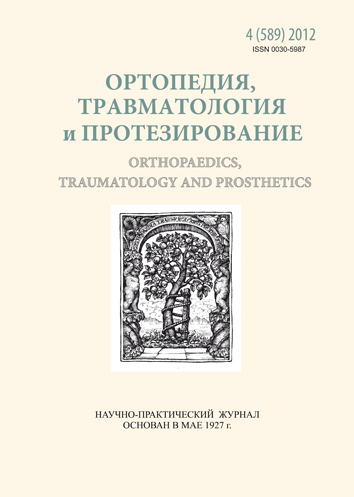Foot neuroosteoarthropathy in case of diabetes mellitus: peculiarities of treatment and orthopaedic provision of patients
DOI:
https://doi.org/10.15674/0030-59872012456-61Keywords:
diabet, neuropathy, neuroosteoarthropathy, orthopaedic provisionAbstract
The examination involved 34 patients with diabetic neuroosteoarthropathy (DNOAP). The acute stage was diagnosed in 7 (20.6 %), subacute in 12 (35.5 %), and chronic in 15 (44.1 %) cases. Ten patients had trophic ulcers of feet in their histories, 24 revealed them on examination. The purpose of the present work was as follows: to stop the foot deformity progression and bone destruction, to heal trophic ulcers, to improve the weight-bearing capacity of the extremity and to restore the act of walking with help of modern methods of treatment and orthopaedic provision. Indications for using orthoses were revealed in 29 (85.3 %) patients with DNOAP. Fixing with a plaster bandage was performed in 5 cases at the acute stage, a total contact orthosis was made for 18 patients (12 with the subacute stage and 4 with the chronic one), an unloading total contact orthosis was used in 2 patients with the acute stage, and an orthosis for the foot with orthopaedic footwear was made in 11 patients with the chronic stage. As a result of the complex of treatment and orthopaedic provision of the patients, trophic ulcers healed in 100 % of cases, the weight-bearing capacity of the extremity increased in 95.8 %, the patients’ mobility became better in 75 %, and their psychoemotional state improved in 66.7 %. All the patients demonstrated better indices of biomechanics. Hence, treatment combined with orthopaedic provision in DNOAP made it possible to heal trophic ulcers and stop progression of foot deformity.
References
- Антонова К. В. Диабетическая полинейропатия: возможности патогенетического воздействия / [Электронный ресурс] / К. В. Антонова // Русский медицинский журнал. — 2011. — Режим доступа к журн.: http://www.rmj.ru.
- Использование Актовегина в медикаментозной терапии осложненных форм синдрома диабетической стопы / [Электронный ресурс] / Б. С. Брискин, А. В. Прошин, Я. И. Якобишвили, Е. В. Кузнецов // Consilium medicum. — 2007. — Т. 09, № 7. — Режим доступа: http://www.old.consilium-medicum.com/article 115146.
- Галстян Г. Р. Поражения нижних конечностей у больных сахарным диабетом / [Электронный ресурс] / Г. Р. Галстян // Consilium medicum. — 2006. — Т. 08, № 9. — Режим доступа: http://www. old.consilium-medicum.com/article113207.
- Гурьева И. В. Профилактика и лечение, медико-социальная реабилитация и организация междисциплинарной помощи больным с синдромом диабетической стопы: автореф. дис… на соискание ученой степени доктора мед. наук / И. В. Гурьева. — М., 2001. — 21 с.
- Протезно-ортопедическое обеспечение в процессе реабилитации инвалидов с сахарным диабетом / Б. Д. Дувидович, С. В. Сергеев, М. И. Пантелеев, Л. В. Кохненко // Медико-социальная экспертиза и реабилитация. — 2004. — № 1. — С. 49–51.
- Креминская В. М. Возможности применения Актовегина при поздних осложнениях сахарного диабета [Электронный ресурс] / В. М. Креминская, И. В. Гурьева // РМЖ. — 2006. — Режим доступа к журн.: http://www.rmj.ru.
- Возможности комплексного хирургического лечения гнойно-некротических поражений нейроишемической формы синдрома диабетической стопы / В. А. Митиш, И. А. Ерошкин, Г. Р. Галстян и др. // Сахарный диабет. — 2009. — № 1. — С. 8–13.
- Синдром диабетической стопы в клинической практике / [Электронный ресурс] / В. Н. Оболенский, Т. В. Семенова, П. Ш. Леваль, А. А. Плотников // Русский медицинский журнал. — 2010. — Т. 18, № 2. — Режим доступа к журн.: http://www.rmj.ru.
- Спивак Б. Г. Клинические проявления патологических изменений стоп у больных диабетом и принципы ортопедического обеспечения / Б. Г. Спивак, И. В. Гурьева // Протезирование и протезостроение: Сборник трудов. — М.: ЦНИИПП, 2000. — Вып. 96. — С. 42–48.
- Токмакова А. Ю. Современная концепция диагностики
- и лечения хронических ран у больных с синдромом диабетической стопы / А. Ю. Токмакова // Сахарный диабет. — 2009. — № 1. — С. 14–17.
- Ульянова И. Н. Нарушение костного метаболизма при синдроме диабетической стопы: дис… канд. мед. наук / И. Н. Ульянова. — М., 2002. — 136 с.
- Шварц Г. Я. Современная комбинированная фармакотерапия остеопороза / [Электронный ресурс] / Г. Я. Шварц // Русский медицинский журнал. — 2011. — Режим доступа к журн.: http://www.rmj.ru.
- Biphosphonates in treatment of Charcot neuroosteoarthopathy: a double-blind randomised controlled trial / E. B. Jude, P. L. Selby, J. Burgess et al. // Diadetologia. — 2001. — Vol. 44. — P. 20–32.
- Klenerman L. The Charcot Joint in Diabetes / L. Klenerman // Diabetic Medicine. — 1996. — № 13. — P. 52–54.
Downloads
How to Cite
Issue
Section
License
Copyright (c) 2014 Ruslan Boboshko, Irina Dondoreva, Michail Zaitsev, Victor Pivovarov

This work is licensed under a Creative Commons Attribution 4.0 International License.
The authors retain the right of authorship of their manuscript and pass the journal the right of the first publication of this article, which automatically become available from the date of publication under the terms of Creative Commons Attribution License, which allows others to freely distribute the published manuscript with mandatory linking to authors of the original research and the first publication of this one in this journal.
Authors have the right to enter into a separate supplemental agreement on the additional non-exclusive distribution of manuscript in the form in which it was published by the journal (i.e. to put work in electronic storage of an institution or publish as a part of the book) while maintaining the reference to the first publication of the manuscript in this journal.
The editorial policy of the journal allows authors and encourages manuscript accommodation online (i.e. in storage of an institution or on the personal websites) as before submission of the manuscript to the editorial office, and during its editorial processing because it contributes to productive scientific discussion and positively affects the efficiency and dynamics of the published manuscript citation (see The Effect of Open Access).














